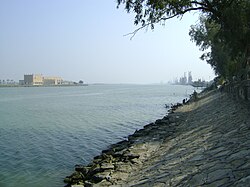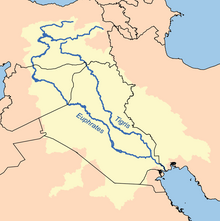Shatt al-Arab
| Shatt al-Arab | |
|---|---|
 | |
 Drainage basin and two major tributaries | |
| Location | |
| Country | Iraq, Iran, Kuwait[1][2] |
| Physical characteristics | |
| Source | Euphrates |
| • elevation | 4 m (13 ft) |
| 2nd source | Tigris |
| • elevation | 4 m (13 ft) |
| Mouth | |
• location | Persian Gulf |
• coordinates | 30°24′15.59″N 48°09′3.60″E / 30.4043306°N 48.1510000°E |
• elevation | 0 m (0 ft) |
| Length | 204 km (127 mi)[3]
|
| Basin size | 938,173 km2 (362,231 sq mi)[3] to 884,000 km2 (341,000 sq mi) |
| Width | |
| • minimum | 250 m (820 ft)[3] |
| • maximum | 1,500 m (4,900 ft)[3] |
| Discharge | |
| • location | Shatt al-Arab Delta, Persian Gulf |
| • average | (Period: 1971–2000)3,535 m3/s (124,800 cu ft/s)[4] (Period: 1977–2018)105.7 km3/a (3,350 m3/s)[3] |
| Discharge | |
| • location | Abadan, Iran |
| • average | (Period: 1971–2000)3,531.6 m3/s (124,720 cu ft/s)[4] |
| Discharge | |
| • location | Basra, Iraq |
| • average | (Period: 1971–2000)2,782.8 m3/s (98,270 cu ft/s)[4] |
| Discharge | |
| • location | Euphrates rivers) |
| • average | (Period: 1971–2000)2,531.8 m3/s (89,410 cu ft/s)[4] |
| Basin features | |
| Tributaries | |
| • left | Euphrates |
The Shatt al-Arab (
The Karun, a tributary which joins the waterway from the Iranian side, deposits large amounts of silt into the river; this necessitates continuous dredging to keep it navigable.[6]
The area used to hold the largest date palm forest in the world. In the mid-1970s, the region included 17–18 million date palms: an estimated one-fifth of the world's 90 million palm trees. However, by 2002, more than 14 million of the palms had been wiped out by the combined factors of war, salt and pests; this count includes around 9 million palms in Iraq and 5 million in Iran. Many of the remaining 3–4 million trees are in poor health.[7]
Geography

The Shatt al-Arab is formed by the confluence of the Tigris and Euphrates rivers at Al-Qurnah, and flows into the Persian Gulf south of the city of Al-Faw.
History
3,000 years ago, the Persian Gulf was larger and the Shatt al-Arab had not yet formed.
Dispute over the river occurred during the Ottoman-Safavid era, prior to the establishment of an independent Iraq in the 20th century. In the early 16th century, the Iranian Safavids gained most of what is present-day Iraq, including Shatt al-Arab. They later lost these territories to the expanding Ottomans following the Peace of Amasya (1555).[8]
In the early 17th century, the Safavids under king (
Later, Nader Shah (r. 1736–1747) succeeded in restoring Iranian control over Shatt al-Arab for a time. With the Treaty of Kerden (1746), however, the Zuhab boundaries were restored, ceding the river to the Turks once again.[10][11] The First Treaty of Erzurum (1823) concluded between Ottoman Turkey and Qajar Iran, resulted in the same.[12][13]
The

During the
The Shatt al-Arab and the forest were depicted in the middle of the coat of arms of the Kingdom of Iraq, from 1932 to 1959.


Under Shah Mohammad Reza Pahlavi in the late 1960s, Iran developed a strong military and took a more assertive stance in the Near East.[14] In April 1969, Iran abrogated the 1937 treaty over the Shatt al-Arab and Iranian ships stopped paying tolls to Iraq when they used the Shatt al-Arab.[17] The Shah argued that the 1937 treaty was unfair to Iran because almost all river borders around the world ran along the thalweg, and because most of the ships that used the Shatt al-Arab were Iranian.[18] Iraq threatened war over the Iranian move, but on 24 April 1969, an Iranian tanker escorted by Iranian warships (Joint Operation Arvand) sailed down the Shatt al-Arab, and Iraq—being the militarily weaker state—did nothing.[15] The Iranian abrogation of the 1937 treaty marked the beginning of a period of acute Iraqi-Iranian tension that was to last until the Algiers Accords of 1975.[15]
All
In 1980, President Saddam Hussein of Iraq abrogated the 1975 treaty and Iraq invaded Iran. The main thrust of the military movement on the ground was across the waterway which was the stage for most of the military battles between the two armies. The waterway was Iraq's only outlet to the Persian Gulf, and thus, its shipping lanes were greatly affected by continuous Iranian attacks.[20]
When
Reports from the front, both at Faw [Fao] and outside Basra, indicated that the Iranian resistance was surprisingly weak. The army that had shown such courage and élan early in the war now broke in a rout, and fled before the Arabs.[24]
During the 1988 battles, the Iranians seemed tired and worn out by the nearly eight years of the war, and "put up very little resistance" to the Iraqi offensives.[25] At the end of the Iran–Iraq War, both sides agreed to once again treat the Algiers Accord as binding.
Conflicts

Iranian–Iraqi dispute
Conflicting territorial claims and disputes over navigation rights between Iran and Iraq were among the main factors for the beginning of the Iran–Iraq War that lasted from 1980 to 1988, when the pre-1980 status quo was restored. The Iranian cities and major ports of Abadan and Khorramshahr and the Iraqi cities and major ports of Basra and Al-Faw are situated along this river.
Gulf War and Iraq War
During the 2003 invasion of Iraq, the waterway was a key military target for the coalition forces. Since it is the only outlet to the Persian Gulf, its capture was important in delivering humanitarian aid to the rest of the country,[citation needed] and stopping the flow of operations trying to break the naval blockade against Iraq.[citation needed] The British Royal Marines staged an amphibious assault to capture the key oil installations and shipping docks located at Umm Qasr on the al-Faw peninsula at the onset of the conflict.
Following the end of the war, the UK was given responsibility, subsequently mandated by United Nations Security Council Resolution 1723, to patrol the waterway and the area of the Persian Gulf surrounding the river mouth. They were tasked until 2007 to make sure that ships in the area were not being used to transport munitions into Iraq. British forces also trained Iraqi naval units to take over the responsibility of guarding their waterways after the Coalition Forces left Iraq in December 2011.
On two separate occasions, Iranian forces operating on the Shatt al-Arab captured British Royal Navy sailors who they claim trespassed into their territory.
- In 2004, several British servicemen were held for Kamal Kharrazi. The initial hardline approach came down to power struggles within the Iranian government. The British marines' weapons and boats were confiscated.
- In 2007, a seizure of fifteen more British personnelbecame a major diplomatic crisis between the two nations. It was resolved after thirteen days when the Iranians unexpectedly released the captives under an "amnesty".
Naming
The river is also known in Iraq as the Dijla al-Awara (دجلة العوراء) and in Iran as the Arvand Rud (Persian: اروندرود, lit. 'Swift River').
The Persian epic poem Shahnameh (written between c. 977–1010 CE) and many other works of Middle Persian literature use the name Arvand (اروند) for the Tigris, the confluent of the Shatt al-Arab.[26] Iranians also used this name specifically to designate the Shatt al-Arab during the later Pahlavi period, and continue to do so since the 1979 Iranian Revolution.[26]
See also
References
- ^ S2CID 248250022.
- ^ "Global Climate Change Impacts on Tigris Euphrates Rivers Basins" (PDF). p. 55.
- ^ .
- ^ a b c d "Tigris Euphrates Delta-Coastal".
- ^ "Shatt al Arab". Oxford Public International Law. Retrieved 23 April 2022.
The Shatt al Arab river (or Arvand Rud in Persian) is the confluence of the Euphrates and the Tigris (Tigris and Euphrates Rivers), which starts in the Iraqi town of Al-Qornah and after circa 120 miles flows into the Persian Gulf.
- ^ "Iraq – Major Geographical Features". country-data.com. Retrieved 28 November 2015.
- ^ "UNEP/GRID-Sioux Falls". unep.net. Retrieved 28 November 2015.
- ^ Mikaberidze 2015, p. xxxi.
- ^ Dougherty & Ghareeb 2013, p. 681.
- ^ Shaw 1991, p. 309.
- ISBN 978-1134429905.
- ^ Kia 2017, p. 21.
- ^ Potts 2004.
- ^ a b Karsh, Efraim The Iran-Iraq War 1980–1988, London: Osprey, 2002 page 7
- ^ a b c d e f g Karsh, Efraim The Iran-Iraq War 1980–1988, London: Osprey, 2002 page 8
- ^ Karsh, Efraim The Iran–Iraq War 1980–1988, London: Osprey, 2002 page7
- ^ Karsh, Efraim, The Iran-Iraq War 1980–1988, London: Osprey, 2002, pp. 7–8
- ^ Bulloch, John and Morris, Harvey The Gulf War, London: Methuen, 1989, p. 37.
- ^ Brogan, Patrick World Conflicts, London: Bloomsbury, 1989, p. 260.
- ^ a b Abadan Archived 2009-08-08 at the Wayback Machine, Sajed Archived 7 October 2014 at the Wayback Machine, Retrieved on March 16, 2009.
- ^ a b Brogan, Patrick page 298
- ^ a b Karsh, Efraim page 57
- ^ Brogan, Patrick, p. 264
- ^ a b Brogan, Patrick, p. 265
- ^ Brogan, Patrick World Conflicts, London: Bloomsbury, 1989, p. 253.
- ^ a b M. Kasheff, Encyclopædia Iranica: Arvand-Rud. – Retrieved on 18 October 2007.
Sources
- Dougherty, Beth K.; Ghareeb, Edmund A. (2013). Historical Dictionary of Iraq (2 ed.). Scarecrow Press. ISBN 978-0810879423.
- Kia, Mehrdad (2017). The Ottoman Empire: A Historical Encyclopedia. ABC-CLIO. ISBN 978-1610693899.
- Mikaberidze, Alexander (2015). Historical Dictionary of Georgia (2 ed.). Rowman & Littlefield. ISBN 978-1442241466.
- Potts, D. T. (2004). "SHATT AL-ARAB". Encyclopaedia Iranica.
- Shaw, Stanford (1991). "Iranian Relations with the Ottoman Empire in the Eighteenth and Nineteenth Centuries". In Avery, Peter; Hambly, Gavin; Melville, Charles (eds.). The Cambridge History of Iran (Vol. 7). Cambridge University Press. ISBN 978-0857451842.
External links
- ICE case: Iran–Iraq War and Waterway rights
- The Iran–Iraq border, 1639–1992, archive Archived 25 December 2018 at the Wayback Machine
